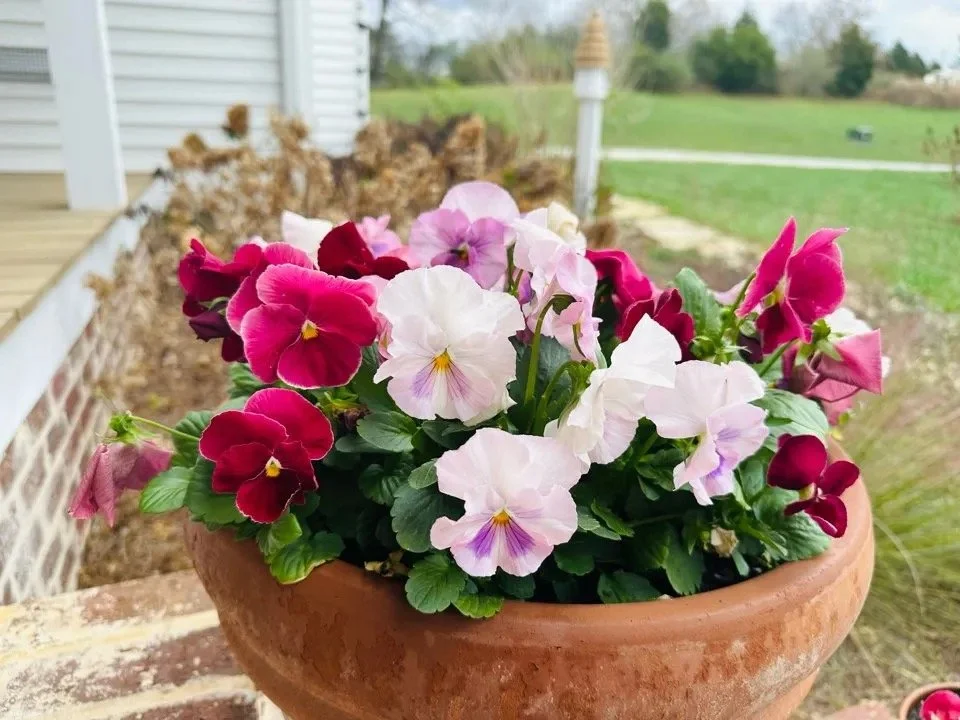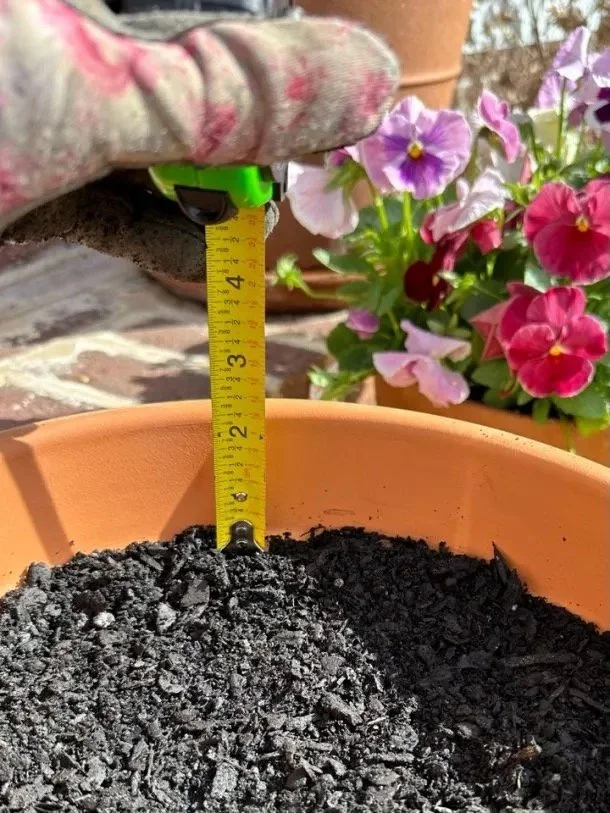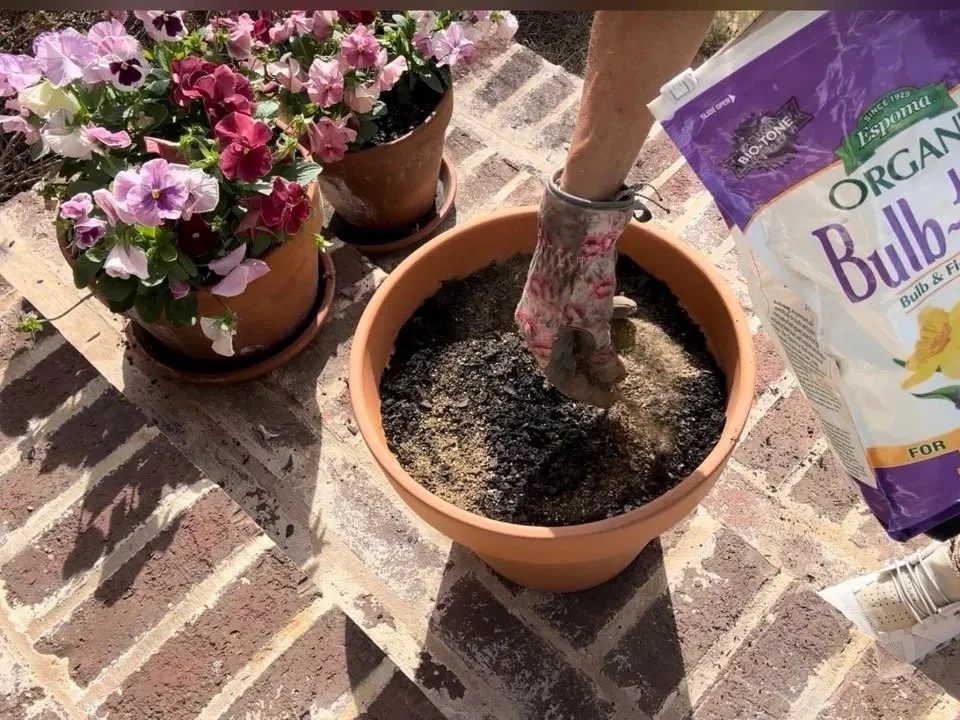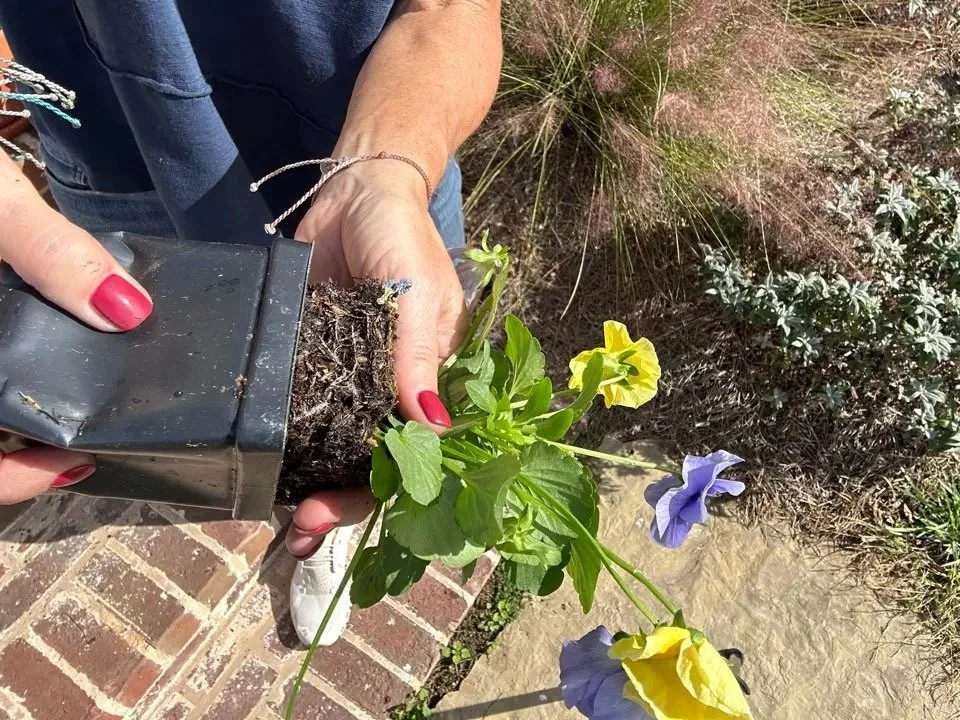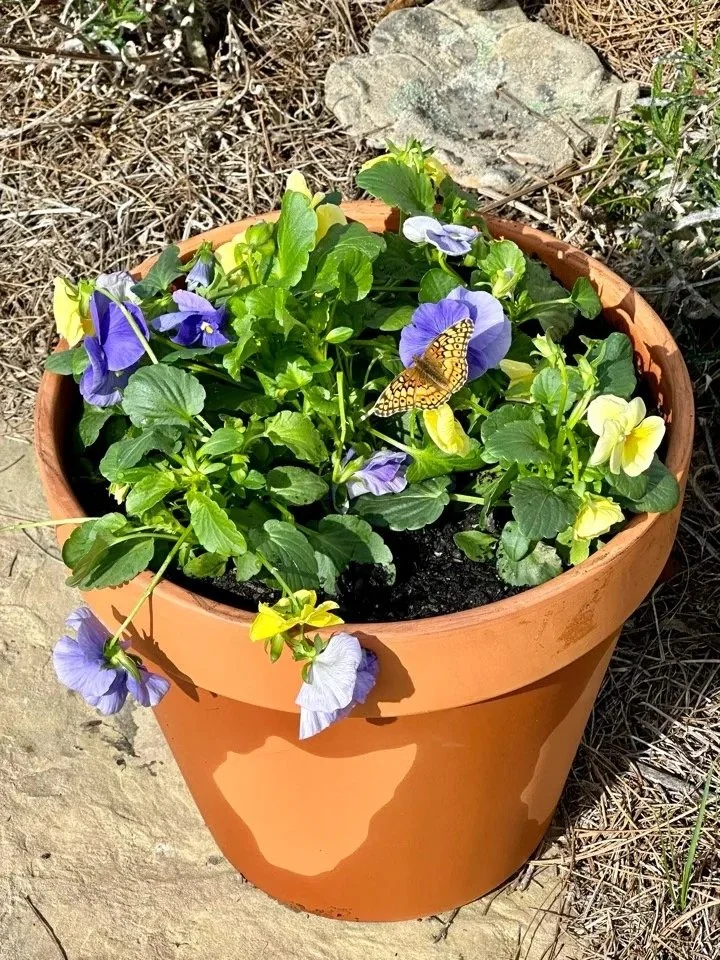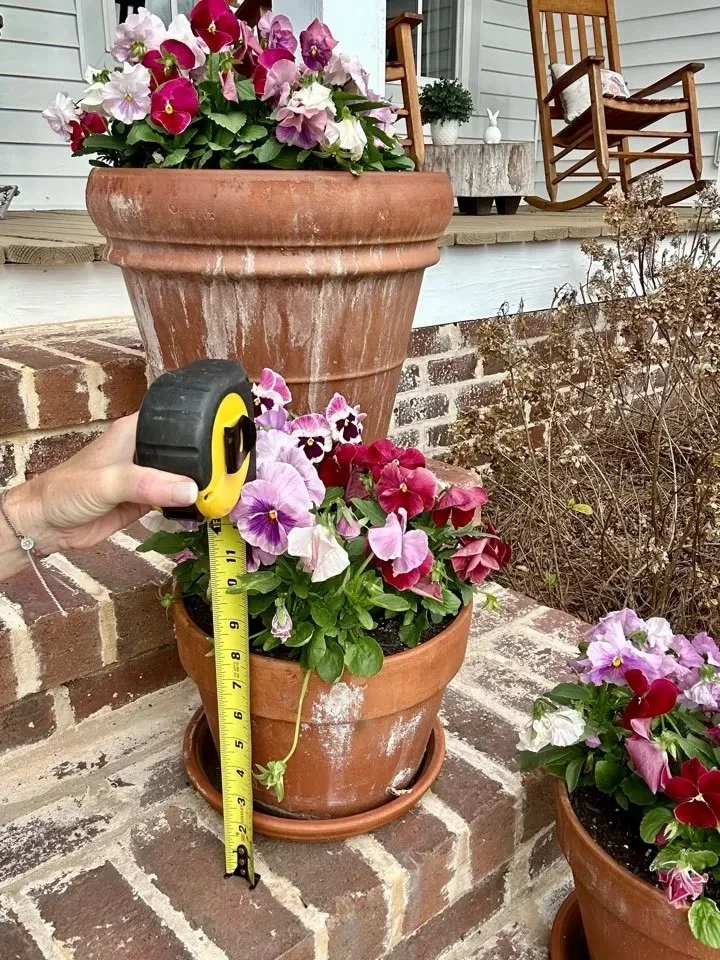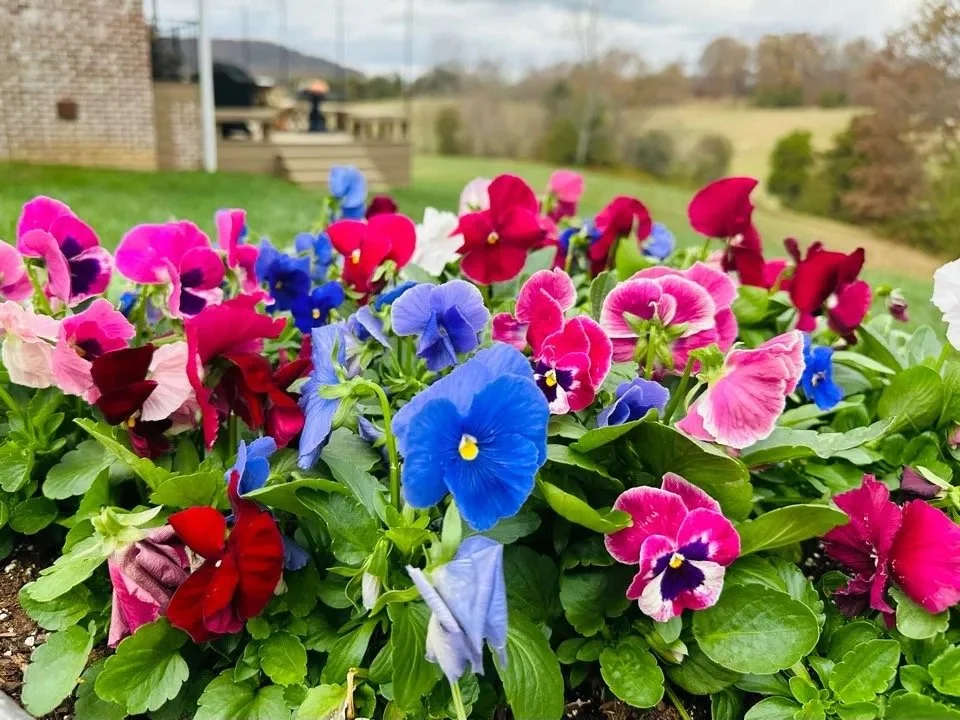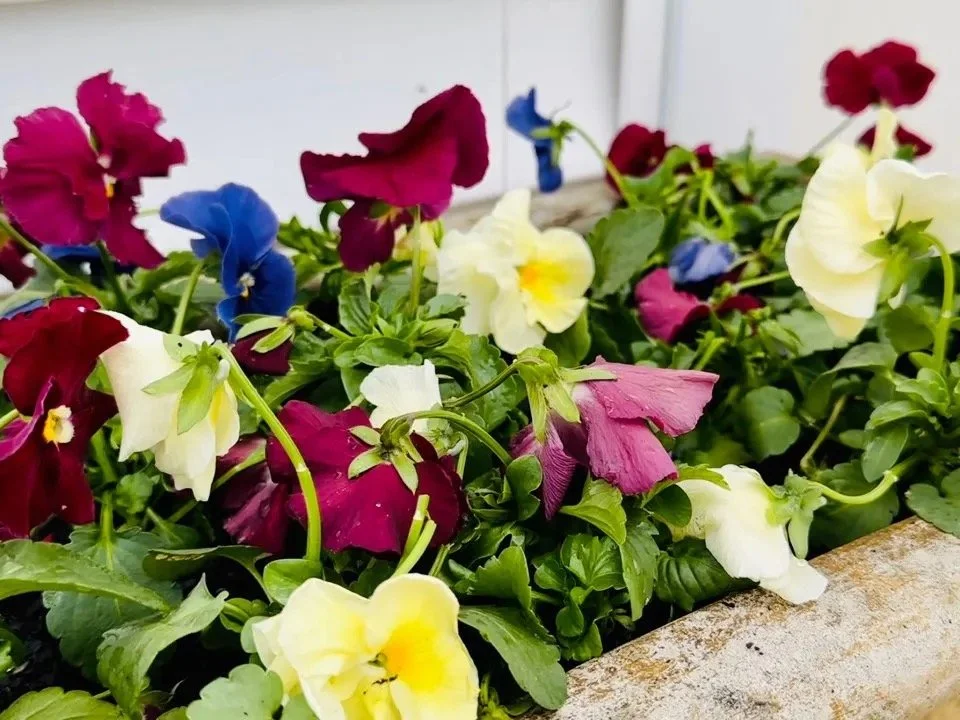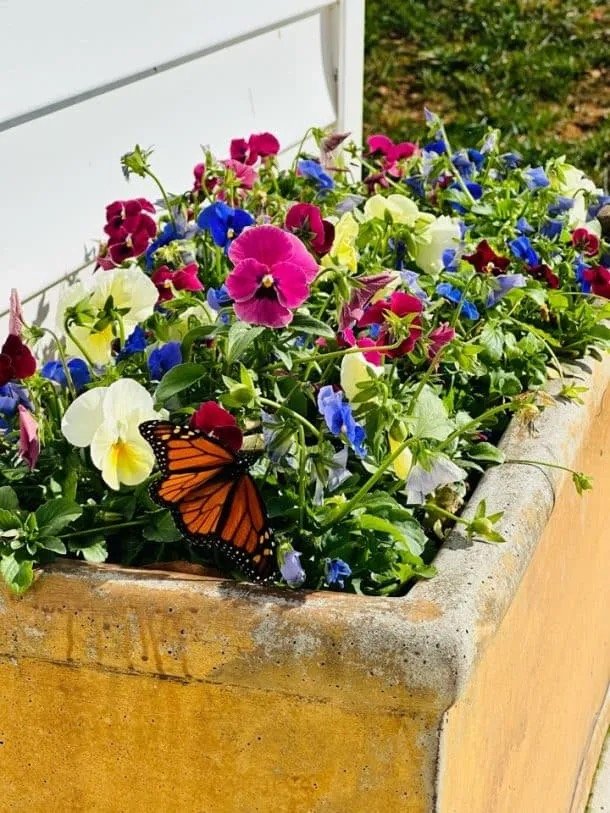How I Plant Pansies in Pots for Winter Flowers: ALL MY TIPS
You want colorful flowers in your containers EVEN IN THE WINTER!
Meet my winter friend, the charming pansy, the perfect flower to grow in winter.
Pansies are lovely cottagey flowers FULL of color. They’re easy peasy!
They aren’t too expensive and they spread.
Not only do they provide blooms in the winter (Zones 6-10), they are gorgeous in the fall and spring, as well.
(For more ideas on how to add interest to your winter garden, see my blog HERE.)
If your summers aren’t too hot, they will stick around for most of the summer.
They could be the longest-blooming annual EVER in zone 7 where I am.
I plant them every fall, enjoy them through the winter, then watch them explode with color in the spring.
They shake off a good frost like it’s pixie dust. A layer of snow freezes them up a bit…then they thaw out and keep doing their thing!
Let me give ALL MY TIPS on how to grow pansies in containers so you can have flowers in winter.
I'll show you, in 8 steps, how I plant pansies in pots for winter flowers and how to care for them in fall, winter, and spring.
(Keep in mind, violas are a cousin to pansies. In fact, all pansies are violas. If you want to learn how to plant violas in winter containers, see my blog HERE.)
How I Plant Pansies in Pots for Winter Flowers: 8 Steps
I think these rose pink, white, and lavender pansies look very “cottagey” in this clay pot on my front porch steps.
1. Plant your pansies in the fall.
Plant your pansies in the fall.
This will give time for their roots to develop before the cold weather moves in.
I generally plant my pansies in October in my zone 7.
2. Water your pansies before you plant them.
Avoid planting pansies with dry soil. Water them before planting to help them endure the stress of the transplant.
You can water your pansies a few hours before or even the day before.
Ideally, you don’t want to plant a pansy with dry soil and roots.
You will be stressing the sweet pansy as you are planting it.
Well-hydrated pansies better handle the stress of the transplant.
3. Add soil to 1-2” below the lip of the container.
Add soil to 1-2″ from the lip of the container. This creates a basin to trap water and prevents soil from washing out with rain and waterings.
Use high-quality potting soil which prevents the soil from compacting.
The 1” left at the top of the container will serve as a basin for water.
It will also prevent soil from washing out as you water it or as it rains.
Sometimes I start with 2" at the top but aim for 1" on my finished product.
4. Fertilize the soil with a balanced fertilizer.
Fertilize the potting soil with a balanced fertilizer to help the roots of the pansies get established before winter.
You can use a 10-10-10 fertilizer (the package will tell you.)
I have also used Bulbtone which concentrates a bit more on root growth.
Use your gloved hand to mix the fertilizer into the soil.
5. Remove your pansies from the nursery container.
Remove your pansies from the nursery container by squeezing each side gently, turning the container upside down, and gently tugging at the base of the pansy.
Remove your pansies from the nursery container by holding on to the side of the container, squeezing it a bit around all sides as you tilt the container upside down gently.
Carefully, pull on the stem of the pansy to release it from the nursery container.
6. Gently break up the roots of the pansy.
Gently break up the roots of the pansies with your hands. This will encourage the roots to reach out into the soil around them creating a healthier plant.
Sometimes you will see the roots of the pansy swirling around the base of the plant.
Use your hands to delicately break those roots up.
This encourages the roots to reach out into the new soil around them instead of continuing to circle the root base.
7. Plant the pansies in the soil 1"-8" apart.
I plant my pansies about 1″ apart in my winter containers but if you are on a budget, you can plant them as much as 8″ apart. Over time, they will spread and fill in the space.
Dig a hole with your gloved hand or a trowel.
Place your pansy in the hole even with the soil around it.
Replace the soil around the pansy. (So easy.)
Then move on to planting the next pansy.
When planting, aim for the top of the soil in the nursery container to be even with the top of the soil in your new container.
In other words, don’t cover the top of the nursery container soil with your potting soil.
Space your pansies 1 - 8” apart, depending on your budget.
Either way, they will fill in the container fully over time.
The closer you space your pansies, the sooner you will have the best show of color.
In a container, I plant my pansies 1 - 2” apart.
8. Water in your pansies.
Water in your pansies after planting to ensure they are off to a good start.
These little beauties are stressed with all the changes - being tugged on, the broken roots, the new fertilizer.
Give them a big drink of water to help them adjust to their new environment.
I water them until it runs out of the bottom of my container.
They will reward you with loveliness!
If some of the potting soil settled, you may need to add a bit more potting soil to the top.
Pansies are number one in my book as a winter flower, but for more ideas on flowers to plant in winter containers, see my favorites HERE.
Tips on Choosing a Container for Growing Pansies in Winter
1. Choose a container with drainage holes.
Choose a container with drainage holes when planting your pansies. In some containers, you may have to drill out the holes yourself.
Pansies don’t like their roots sitting in water or soggy soil.
The roots will rot and there’s no coming back from that.
The best way to avoid this is to choose a container with drainage holes.
Sometimes you have to drill out the holes in the container yourself.
Either way, be sure to use a container with drainage holes.
2. Choose a container that can handle the winter cold.
Choose a container that won’t freeze and crack during the winter.
Clay pots are porous and are prone to absorbing water.
When the temps drop, they freeze and crack.
Sometimes concrete pots can do the same.
I am in zone 7 and rarely have a problem with either.
My concrete pots are heavy and thick and offer good insulation with no risk of cracking.
Even my larger clay pots have done well.
You also might want to consider a polyresin container.
They don’t crack and they offer some insulation, as well.
3. Choose a container with sufficient depth.
Pansies' roots are not that extensive so you can plant pansies in smaller containers.
If I am planting my pansies in the fall, I like to think ahead and protect them as much as possible from the cold winter that is coming.
I use a container that has room for at least 3” below my pansies when I purchase them.
The smallest container I used this year is 8” tall.
When planting your pansies in containers for the winter, choose a container with sufficient depth. An 8″ container was the smallest I used for my pansies this year.
It is also the container I am most concerned about weathering the winter well.
I may decide to bring it into my unheated garage if we have an extended cold snap.
The smaller containers also seem to dry out faster so they need to be watered more frequently.
Smaller containers are cute and I love them but they often need more attention.
Tips on Choosing a Location for your Winter Pansy Container
1. Choose a full sun location for your pansy container.
Pansies will bloom well for you in a location where they receive at least 6 hours of sun in the cooler weather.
Some of my containers get a lot more sun than that and they thrive in the fall, winter, and spring.
Be sure to choose a location where your pansies can sunbathe.
2. Move your pansy container to a part-sun spot in summer.
If you want to keep your pansies blooming happily for as long as possible, consider moving your containers in the heat of summer to a location where they get only morning sun or perhaps filtered sun.
When the temperatures heat up in the summer, pansies tend to get leggy and/or wilt.
They are a little bit of a pansy in the heat. (That wasn’t funny, was it?:)
A part-sun location in the heat of summer will help your pansies last longer.
3. Replace your pansies with annuals when the temps rise.
I planted some pansies last year that lasted into July.
Generally, however, I pull up my pansies in my containers around May and replace them with summer flowers.
Sometimes this is difficult because my pansies may still look good (so hard), but I do it because I know they aren’t going to last much longer in zone 7.
You can consider all of this when determining the best location for your container.
Tips on Choosing Pansies for your Winter Container
Which color should you choose?
Don’t let anyone tell you how to do this. These are YOUR pansies!
Just go in and choose the ones that catch your eye first. This is all about what makes you happy.
You can plant all the same color or mix colors. Or you can buy packages that are already mixed.
I have done all of the above at one time or the other.
My kids’ grandmother likes all yellow. My mom tends to go for purple and yellow.
I change my preferences all the time but love a cottage look.
The pale yellow looks so dreamy with light rose or pink.
I also have a crush on blue pansies.
I always love pink shades but this electric blue has my heart too. There isn’t a bad color combination with pansies! Choose what you like and plant them!
Which variety should you choose?
There are different varieties of pansies. Some will trail and some are mounding.
There are solid-colored pansies, blotched pansies, pansies with whiskers (yikes! but, if you look at the center of these beauties, you will see little lines coming out from the middle like little drawn-on whiskers), pansies with ruffled petals, and all with various sized blooms.
At the end of the day, they are ALL SO CUTE!
You can't go wrong.
Just be sure to buy pansies for your zone. Some pansies grow better in slightly warmer or colder temps.
How many winter pansies should you buy to fill your pot?
Pansies will spread in your container. If you are on a budget, space them 6-8” apart. They will fill in over time. If you want instant impact and can afford it, plant them 1-2” apart. They will fill in even tighter within a few weeks, especially in the spring.
This is a picture I took immediately after I planted and watered these pansies. You can see that I planted them pretty close together.
Should you choose pansies that are already blooming?
Narrow down which color(s) and variety you want.
Then look at the pansies within that selection.
I always choose pansies that are in bloom so I know I’m getting the color I want and I’m getting instant gratification when I plant them.
After they bloom, you can deadhead them. If they get straggly, you can cut them back by half or even a bit more.
Just don’t cut below the last group of leaves on the stem when you deadhead.
The other option is to choose pansies that are just getting ready to bloom.
They might transplant better and you get a younger plant, but you run the risk of getting something (a color or variety) you didn’t choose.
This has happened a lot to me.
Not the end of the world but if I have taken time to decide what I want, then I want to be sure it’s what I’m paying for.
The bottom line, pansies are easy.
Buying pansies already in bloom is my choice every time but you'll be fine buying them at any stage.
Most importantly, check to be sure the pansies you select look healthy and full.
How to Care for your Pansies in the Fall
This is a container filled with a combination of pansies and violas. I’m not the only one who thinks they are cute and colorful. This Monarch butterfly chose to stop here and have a snack on his way further south this fall.
I prepare my pansies for winter in the fall by doing everything I can to ensure their roots are well-developed.
I plant them early enough in the fall to give their roots time to develop.
I fertilize them during planting to encourage root development.
I place them in full sun. (At least 6 hours of sun daily.)
I water them well in the fall (maybe every other day or two) to encourage root growth.
Following these tips will provide you with the best display of blooms from your pansies in the fall but will also prepare your pansies for the cold weather on the way in the winter.
How to Care for your Pansies in Winter
During the winter, your pansies will be resting.
It will be too cold during the winter in zone 7 for root development.
It’s almost as though they are frozen where they are until spring.
Whatever blooms you start with when the cold weather strikes, will be what you should have when the cold weather lifts.
When a frost hits, the pansies will shake it off like a refreshing dip in a cold stream.
When the freezing temperatures hit, the pansies will freeze and then will thaw out when the weather warms back up.
Even if they take a hit with some extended cold, they will most often bounce back when the temps warm up.
They are tough little beauties.
Here are a few tips for caring for your pansies in winter:
Water your pansies about once a week if it doesn’t rain throughout the winter when temperatures are above freezing. This will help them endure the cold and ensure they keep performing for you.
Don’t fertilize your pansies during the winter. Wait until the weather begins to warm up before fertilizing.
You may want to bring your pansy containers into an unheated garage or shed if the temperatures dip below 20 degrees for an extended time. Another option is to cover your containers with evergreen boughs or pine straw to protect them.
I’m in Zone 7 and have never moved my containers or covered them. Even if my pansies take a hit during a really cold winter, they have always bounced back for me in the spring. (I LOVE THESE TENACIOUS LITTLE FLOWERS.)
To be honest, I do nothing with my pansies in the winter except enjoy their winter color and charm. They are friends of the lazy gardener.
How to Care for your Pansies in the Spring
When the temperatures begin to warm a bit in the spring, it’s time to give your pansies a good long drink of water.
When you’re sure your pansies are well-hydrated, fertilize your pansies with a balanced fertilizer. (10-10-10, you can look at your fertilizer's packaging to see its NPK rating.)
Deadhead any spent blooms. Pinch back the stem of your already-bloomed pansy, being sure to leave at least a pair of leaves on the stem. This will encourage more flowering.
Keep your pansies well-watered through the spring, routinely deadhead them, and fertilize them every couple of weeks.
When the summer heat begins to move in, move your containers to an area that receives only morning sun or filtered sun. Or you can replace the pansies in your container with summer annuals.
Okay, so there are all my tips for spring.
Honestly, though, all I usually do is make sure my pansies are well-watered then I will fertilize them around the first of March.
I might deadhead them if needed. After that, I will water them every couple of days.
I might fertilize them one more time.
They are usually so full and bursting with color at that point, I won’t fertilize them again.
They are like a machine. They produce a mound of relentless color until the heat of summer hits.
I rarely even deadhead them after the initial time. SO EASY!
Wrapping It Up
In zone 7, where I live, my pansies cannot survive the summer heat.
I pull them out around May and replace them with summer annuals.
It is always such a hard thing for me to do because they often still look amazing.
However, I know they only have a few more weeks left in them and I like getting my summer annuals planted in May.
Overall, these little charmers will have lasted for 8 months at my house, remaining in bloom the entire time.
They will have even survived the cold of winter.
They are WARRIORS disguised as sweet cheerful smiles in your container.
You want them in your arsenal for the winter blues!
Let’s get these beauties in our winter containers!

